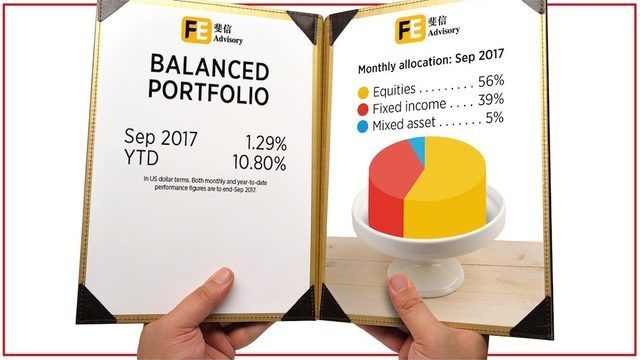Each month we feature the allocation in one of the three portfolios offered by FE Advisory Asia: cautious, balanced and growth. Data is included to show how well the portfolio has done compared to the previous month and year-to-date so that readers can get a sense of performance.
Additionally, Luke Ng, senior VP of research at FE Advisory Asia, provides a concise analysis on macro events and their potential impact on the portfolio.
A breakdown of the balanced portfolio at the end of September 2017. Performance figures are in the menu image above.

Portfolio breakdown and holdings are based on latest published data for each constituent, which may have publication dates that differ.
Percentages are based on current holdings and should only be used as a guide. Some information is provided to FE from independent third parties whom FE does not control. FE cannot guarantee the accuracy or reliability of the data, or its suitability for use by all investors.

Luke Ng, FE Advisory Asia
How did the market perform in September?
We finally saw developed market equities outperforming emerging markets in 2017. The EU and the UK led the gains among the developed markets in US dollar terms. The former saw continuous surprises on the macroeconomic front, with the PMI indicating strong growth in job creation and output. Production output was boosted by a strengthening of the pound sterling amid the Bank of England’s potential rise in interest rates.
In the US, hurricanes Harvey and Irma led to a deterioration in economic data and forward-looking activity indicators. However, markets were relatively sanguine, with investors believing the impact to be transitory. This was a view supported by statements from the Fed.
Meanwhile in Japan, inflation jumped to 0.7% whilst industrial production figures were better than expected. Moreover, all eyes are on the October 22 snap general election called by Prime Minister Abe.
In emerging markets, Brazil proved a bright spot due to positive news over job creation and consumer confidence. The market was further boosted by an interest rate cut by the central bank during the month. An uptick in the oil price also laid support for Russia, despite emerging Europe underperforming her peers amid market weakness shown in Turkey and Greece. In Asia, Korea outperformed its regional neighbours, thanks to a stronger run by the technology sector. India, however, lagged amidst concern over the recent spike in inflation and this partly triggered off some outflows from the Indian equity market.
With hints from the major central banks over monetary tightening, bond yields generally rose over the month. Together with the strengthening in the US dollar, the Bloomberg Barclays Global Aggregate Index posted a negative return and fell 0.90% in September.
How did the Balanced portfolio perform?
Our balanced portfolio gained 1.29% in September, bringing a 10.80% return for year-to-September in US dollar terms. Thanks to a rising oil price, our holding in the energy sector – which been a drag on performance for several months, rebounded sharply and helped post a double-digit return. This roughly contributed half of the portfolio return in September. While dividend stocks were underperformers among Chinese equities, our holding in the Matthews Asia China Dividend Fund– which has a stronger focus on dividend-paying smaller caps – stood up strongly and outperformed that of the wider Chinese equity market. In Asia, momentum stocks continued to outpace that of the quality stocks. Our holding in the First State Asia Opportunities lagged due to its strong bias toward qualities. It was the only equity exposure held in our portfolio that delivered a negative return over the month.
Within our fixed income exposure, our holdings fell alongside that of the market amid the rising bond yields. However, we were able to provide better downside protection versus the Bloomberg Barclays Global Aggregate due to our stronger focus on US dollar instruments.
FE Advisory Asia 2017 portfolio results
| Jan | Feb | Mar | Apr | May | Jun | First half of 2017 | |
| Cautious | 0.78% | 1.28% | 0.77% | 0.71% | 1.05% | 0.44% | 5.15% |
| Balanced | 2.03% | 0.78% | 0.19% | 1.23% | 1.85% | 0.44% | 6.69% |
| Growth | 2.57% | 2.00% | 0.53% | 1.19% | 2.81% | 0.17% | 9.61% |
| Jul | Aug | Sept | YTD | |
| Cautious | 0.68% | 1.16% | 0.34% | 7.45% |
| Balanced | 1.11% | 1.40% | 1.29% | 10.80% |
| Growth | 2.01% | 1.69% | 1.87% | 15.83% |
Source: FE Advisory Asia. Growth rates in US dollar terms. YTD to end of September 2017.

















